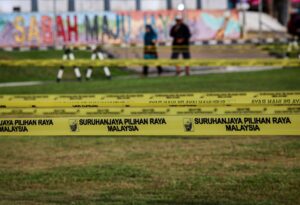BEIJING, Aug. 15 (Xinhua) — Exhibitions and various other memorial activities have been organized across China to commemorate the 80th anniversary of Japan’s announcement of unconditional surrender in World War II (WWII).
On Aug. 15, 1945, Japan announced its unconditional surrender. Following the announcement, Japan sent representatives to Zhijiang County of Hunan Province to hand over a map of Japanese troops deployed in China, and to sign a memorandum of surrender.
On Friday, an exhibition titled “WWII: Zhijiang,” featuring 61 historical photos, was unveiled at a hall memorializing Japan’s surrender in Zhijiang.
The photos are on public display in China for the first time. Visitors slowed their pace, some standing quietly in front of the display board to contemplate the historical images.
According to Wu Jianhong, curator of the memorial hall, the photos were collected by Zhijiang-born painter Qian Dexiang and his wife, Tan Mingli.
The couple discovered a booklet about Zhijiang’s WWII history that contained historical photos in the United States. The photos vividly portray the people of Zhijiang and their struggle against aggression, as well as Chinese military personnel and civilians fighting alongside their American peers, and moments from the victory celebrations.
“The release of these photos is not only intended to revisit Zhijiang’s wartime history — it is also a profound remembrance of the county’s countless fallen heroes,” Wu said. “Looking back at history is meant to help us move forward.”
In Nanjing — the site of the horrific Nanjing Massacre during WWII — six individuals were on Friday recognized as “inheritors of historical memories of the Nanjing Massacre” during a ceremony held at the Memorial Hall of the Victims in Nanjing Massacre by Japanese Invaders.
There are now 38 such inheritors. Notably, that number now includes two foreign nationals for the first time: Thomas Rabe and Megan Brady, both of whom are descendants of international personnel who had helped save Chinese people and recorded the horrific history of the war in China.
Thomas Rabe is the grandson of German businessman John Rabe, who joined other foreigners to establish an international safe zone during the massacre, saving over 250,000 Chinese lives. The diaries of John Rabe remain among the most comprehensive historical records of the atrocity.
Megan Brady is the great-granddaughter of Richard Brady, a U.S. surgeon who aided civilians in Nanjing and documented the atrocities of the Japanese army through diary entries, photographs and letters.
The Nanjing Massacre took place when Japanese troops captured the then Chinese capital on Dec. 13, 1937. Over a period of six weeks, they killed approximately 300,000 Chinese civilians and unarmed soldiers in one of the most barbaric episodes of WWII.
Also on Friday, a special exhibition titled “Justice Trial” opened at the September 18th Historical Museum in Shenyang, Liaoning Province, showcasing historical facts related to trials of Japanese war criminals.
The exhibition features more than 200 photographs and over 100 other items, as well as archival materials. It documents the public trials, as well as the subsequent verdicts, of 45 Japanese war criminals conducted by a special military tribunal of the Supreme People’s Court of the People’s Republic of China (PRC).
Fan Lihong, curator of the September 18th Historical Museum, told Xinhua that these trials were the first trials on Japanese war criminals conducted by the Chinese people on their own territory after the founding of the PRC. They were carried out independently and without external interference, holding significant international influence and historic importance.
In southwest China’s Chongqing Municipality, a guided tour was organized on Friday morning. Participants set off from the city’s iconic People’s Liberation Monument and walked all the way to a museum which presents visitors with information about the Japanese bombing in Chongqing.
“I have been deeply moved along this journey,” said Chen Junfeng, who participated in the tour. “The People’s Liberation Monument used to be a monument to victory in the Chinese People’s War of Resistance against Japanese Aggression, and now it stands amid towering skyscrapers as a landmark of the city. These changes have all been achieved through the sacrifices and bloodshed of our forebears.”




